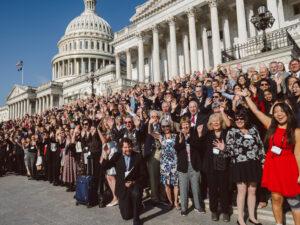By Jerry Hinkle
Here at CCL, we’re always taking action to push the U.S. Congress to implement a national carbon price. This summer, it has become abundantly clear that the rest of the world is taking their own actions on climate that are pushing America toward a carbon price, too. The EU, for example, has proposed a Carbon Border Adjustment Mechanism (CBAM) for implementation in January 2023. Canada, too, is planning to implement a CBAM.
Each of those policies carries economic implications for the U.S. Some U.S. industries will be directly impacted by the CBAMs and will likely lose export sales when the mechanisms are implemented. Employment will decline accordingly.
But the flip side of that scenario is positive: if the U.S. enacts its own carbon tax policy with a corresponding CBAM, sales and employment will likely grow in those same industries.
Let’s explore how each option could play out.
How the EU’s CBAM works
Here’s how the EU’s CBAM works. Initially, it will cover cement, electricity, fertilizer, iron and steel, and aluminum. This group should expand over time to include other “energy-intensive, trade-exposed” (EITE) products. The EU carbon prices are currently just over €55 ($65) and are expected to rise between now and CBAM implementation.
Currently, the EU producers of the EITE products are at a disadvantage relative to foreign competitors (e.g., U.S. exporters) because they have to pay this $65/ton carbon price (1), thereby increasing their cost of production, while the foreign (U.S.) firms do not. This is exactly what the CBAM is designed to counter. Once the EU CBAM is implemented in 2023, the U.S. imports will be charged the carbon price at the border (2), and the U.S. cost of production advantage/EU disadvantage will disappear. The CBAM will allow the EU to increase carbon prices to the level necessary to achieve their ambitious climate goals without concern that their EITE firms will either 1) be at a competitive disadvantage from the carbon price and so lose sales or 2) move operations to countries without a carbon price (i.e., “leakage”).
However, the EU CBAM will eliminate the cost advantage currently enjoyed by U.S. exports to Europe (appropriately), and this will reduce U.S. sales of these products and cost jobs in those industries. This should play out similarly when Canada also implements its CBAM. This is significant because these are the two largest buyers of U.S. exports.
How the U.S. can respond
What can the U.S. do in response? According to a recent analysis, a U.S. carbon price with CBAM might not help our EITE trade with the EU, but could give us a significant advantage with other major trading partners. Specifically, the EU is designing its CBAM to charge the imports based on the carbon-intensity of the exporting country. Its internal carbon price charges the tax based on how much carbon the EU emits in producing the good, but the EITE trade goods coming in are charged the tax based on how much carbon the exporting firm emits in producing the same good. Under this approach, a CBAM gives a competitive advantage to the cleaner country.
If the US’s CBAM were to be designed similarly to the EU’s (3), the U.S. EITE industries would realize a significant advantage because they have much cleaner production processes (see page 2 of the analysis) than China, Russia and India, and to a lesser extent, Canada and Mexico. In fact, 75% of U.S. imports come from countries that are more carbon intensive. As a result, U.S. EITE firms would surely see sales and employment gains. For example, this analysis estimates that domestic sales of steel products would rise almost 10% as a result of a $40/ton carbon fee and dividend policy with CBAM, and that the benefits would be widespread throughout the country.
The IMF has already made clear that a carbon tax policy will grow the economy (CH 3, pg. 100) and increase employment (pg. 92). Should the U.S. enact a carbon tax with a CBAM designed similar to that of Europe, U.S. EITE industries will get a clear boost as well.
Footnotes:
- The increased cost of production from the CP is partially offset by free pollution permit allowances and subsidies.
- The EU importer pays the CP, but who pays is of no consequence here.
- It is uncertain if the US will charge imports based on the US carbon pollution from the product or, like the EU, based on the exporting firm’s carbon pollution from producing the product. The latter would make the CBAM more complex.
Jerry Hinkle is a research coordinator for CCL.





